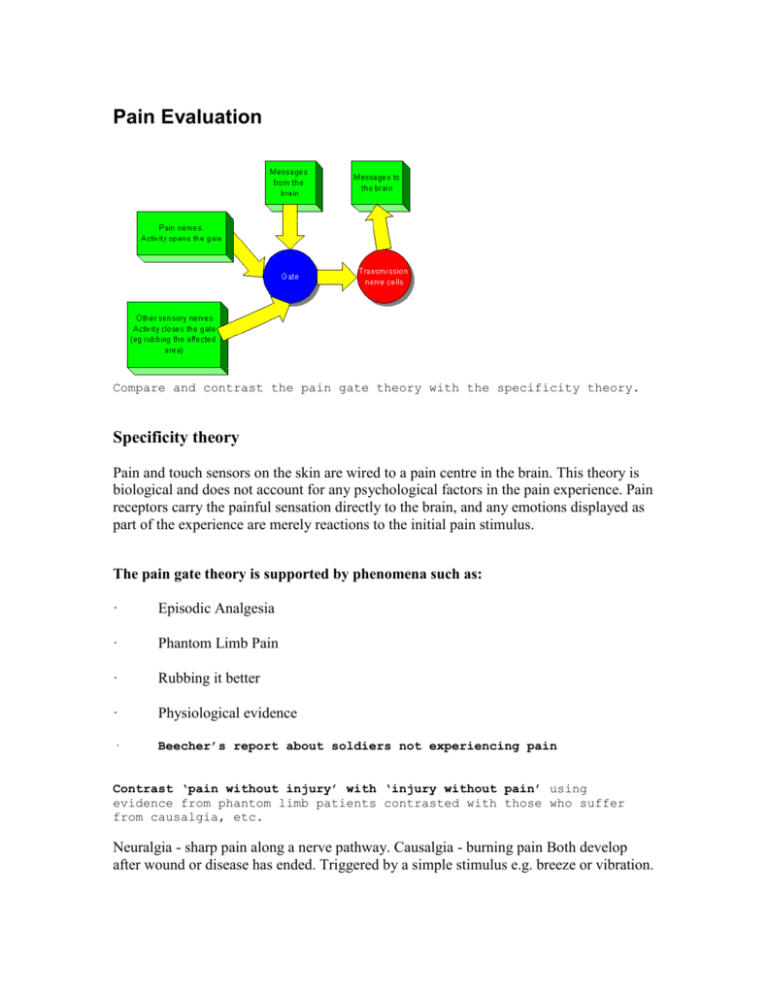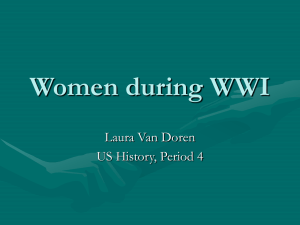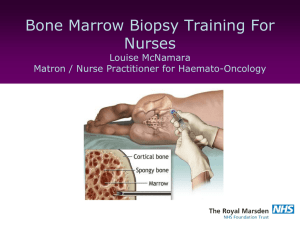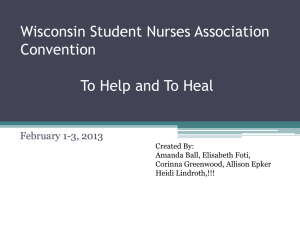Pain Evaluation
advertisement

Pain Evaluation Compare and contrast the pain gate theory with the specificity theory. Specificity theory Pain and touch sensors on the skin are wired to a pain centre in the brain. This theory is biological and does not account for any psychological factors in the pain experience. Pain receptors carry the painful sensation directly to the brain, and any emotions displayed as part of the experience are merely reactions to the initial pain stimulus. The pain gate theory is supported by phenomena such as: · Episodic Analgesia · Phantom Limb Pain · Rubbing it better · Physiological evidence · Beecher’s report about soldiers not experiencing pain Contrast ‘pain without injury’ with ‘injury without pain’ using evidence from phantom limb patients contrasted with those who suffer from causalgia, etc. Neuralgia - sharp pain along a nerve pathway. Causalgia - burning pain Both develop after wound or disease has ended. Triggered by a simple stimulus e.g. breeze or vibration. Case study method – subjective / objective measures Charles Murray and Melzack worked with Miss C who suffered from congenital analgesia. Case studies can be subjective but Murray uses objective measurements such as heart-rate, blood pressure and respiration rate. Nature/Nurture debate There is strong evidence that Melzack’s neuromatrix is nature (present from birth) rather than nurture (the brain learning about the location of pain sensations) as people born without limbs can experience phantom limb pain. The behaviourist approach is exemplified by Gil et al (1988) –and Block et al (1980). Karen Gil et al (1988) observed parents with children who had a skin disease. The doctor had advised the child not to scratch the skin, which was itchy. Parents who gave more attention to the scratching behaviour seemed to be encouraging the behaviour, because scratching increased! Block et al (1980) found that patients reported more pain in an interview if they knew their spouse was watching behind a one-way mirror and their spouse was concerned about their pain. Demand Characteristics / Placebo effect A team based at the University of Michigan led by Tor Wager, gave people a cream that they said would reduce the pain of the shock they were about to experience. Actually the cream was ineffectual - a placebo. They then scanned the participants' brains while they received the shock, with or without the cream. The researchers found the cream led to reduced levels of activity in those areas of the brain associated with the experience of pain. Moreover, the participants said the shock hurt less with the cream. This finding provides robust evidence that the 'placebo effect' is not 'all in the mind', it's in the brain too. Wager (2004) demonstrates that the placebo effect is not just in the mind and therefore possibly owing to demand characteristics, but also because there are physiological changes to the neural pathways in the brain. Individual differences Use the studies that look at culture. In the pole swinging ceremony reported by Melzack it is not clear whether the suspended man feels pain or not. He might have learnt to suppress his pain expressions. Although it seems likely he doesn’t feel pain it would be difficult to measure pain at a ceremony! Ethics Psychologists have identified cross-cultural differences in the expression of pain. If medical practitioners know of these differences then they might stereotype the patients. For example an Italian might be denied pain relief because the staff believe he is over-expressing his pain. Davitz and Davitz (1985) demonstrated that medical professionals do stereotype patients. Davitz & Davitz (1985) said that if nurses are asked directly about the question of cultural stereotypes and pain, they resent any implication that they operate on the basis of cultural stereotypes. To find out whether nurses are influenced by stereotypes they presented American nurses with a brief vignette describing an adult patient. Sample vignette Name of patient: Michael O’Hara Age:37 Background: Irish Michael O’Hara, struck by an automobile, was admitted to the hospital with a fractured femur and facial injuries. Currently in traction, he is to remain hospitalised for an indefinite period. The experimenters first of all varied the cultural background of the person, so that each patient had the same physical condition, age and sex but a different ethnic background. The six ethnic background variables were: Oriental, Mediterranean, Black, Spanish, Anglo-Saxon, Germanic and Jewish. They also investigated varying the severity of the illness (mild, moderate and severe). The mean ratings of physical pain and psychological distress for each group of patients and for each level of severity of illness were measured. For both physical pain and psychological distress, nurses believed that Jewish and Spanish patients suffered most, while Oriental and Anglo-Saxon/Germanic patients suffered the least. Jewish patients were perceived as suffering relatively greater pain and psychological distress in cases of psychiatric and cardiovascular illnesses. Social Desirability in Self-reports Davitz & Davitz (1985) say: The results of this research clearly indicate that one aspect of American nurses’ belief systems about suffering involves the ethnic or religious backgrounds of their patients. In discussing our research with nurses, we have found that some nurses react defensively to our findings. They strenuously insist that they never generalise, that they treat all patients as individuals. That may indeed be the case for particular nurses, but our data do indicate that in general, American nurses in fact tend to share certain generalised beliefs about patients. Control / Ecological Validity Davitz and Davitz’s (1985) experiment was well controlled but lacked ecological validity. The nurses were not considering real patients that were under their care, but considered fictitious descriptions instead. Measuring Pain notes Physiological measures of pain Muscle tension is associated with painful conditions such as headaches and lower backache, and it can be measured using an electromyograph (EMG). This apparatus measures electrical activity in the muscles, which is a sign of how tense they are. Some link has been established between headaches and EMG patterns, but EMG recordings do not generally correlate with pain perception (Chapman et al 1985) and EMG measurements have not been shown to be a useful way of measuring pain. Another approach has been to relate pain to autonomic arousal. By taking measures of pulse rate, skin conductance and skin temperature, it may be possible to measure the physiological arousal caused by experiencing pain. Finally, since pain is perceived within the brain, it may he possible to measure brain activity, using an electroencephalograph (EEG), in order to determine the extent to which an individual is experiencing pain. It has been shown that subjective reports of pain do correlate with electrical changes that show up as peaks in EEG recordings. Moreover, when analgesics are given, both pain report and waveform amplitude on the EEG are decreased (Chapman et al, 1985). Method Advantages Disadvantages Neurophysiological EMG EEG Observation Objective Cost - training Not valid (Chapman 1985) Valid (Chapman 1985) Valid UAB easy to use Reliable Self-report Risk of subjectivity if observers are not adequately trained. Concurrent validity can be low if compared with self-report method. Subjective Visual Analogue Scale Useful Can track changes Reductionist McGill Pain Questionnaire Validity if used in a pain clinic or for research Not reductionist Limited use in clinical environment Literacy Cognitive state Attention span Controlling Pain notes Chemicals Disadvantages: Side effects Tolerance Addiction Usefulness - by self-administering drugs the patient's sense of control was increased and they therefore required less of the drug. Can be linked to the Pain Gate Theory (PGT) - the brain is less worried about being able to control the pain so closes the gate. Usefulness - the flavoured syrup technique for weaning patients off their drug - not useful for chronic progressive pain or for those receiving benefits. Expense - Biofeedback compared to relaxation. Usefulness - Biofeedback is good for migraines but is not useful for other types of pain. Better for young people but this could be a cohort effect. Usefulness - imagery is more portable than distraction. Both are only useful for mild or moderate pain. Hypnosis is really just like relaxation and distraction. Individual differences - Imagery only suited for people with good imaginations. Hypnosis only suited for those that can be easily hypnotised. Lack of control groups - many of these studies lack a control group with which to compare the results. If there was a control group, having a no-treatment group could be considered as unethical. Psychodynamic approach compared with the behavioural approach. Insight-oriented psychotherapy (psychodynamic) and behavioural techniques both consider the patient to be playing 'pain games', but Insight-oriented psychotherapy tries to establish the cause in the patient's past whereas the behavioural approach only treats the symptoms.







